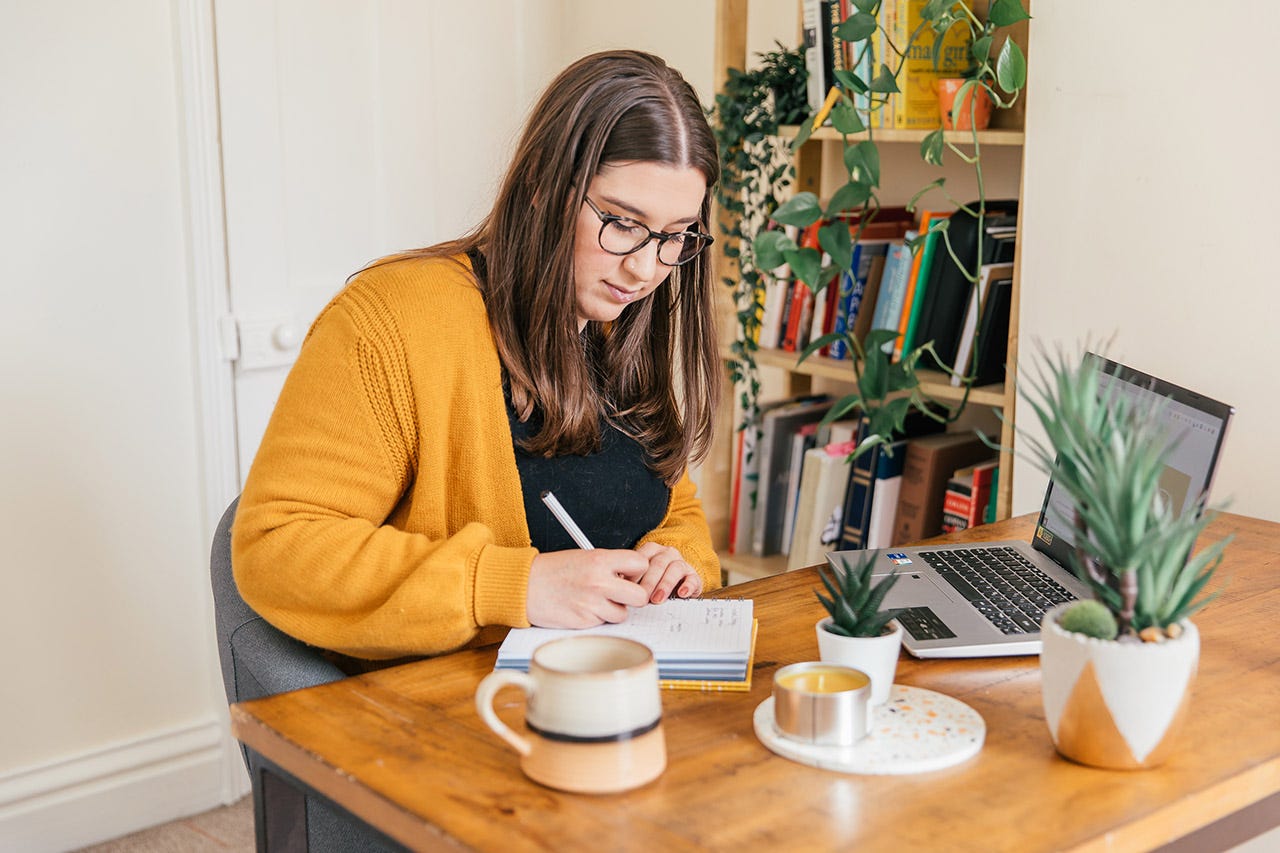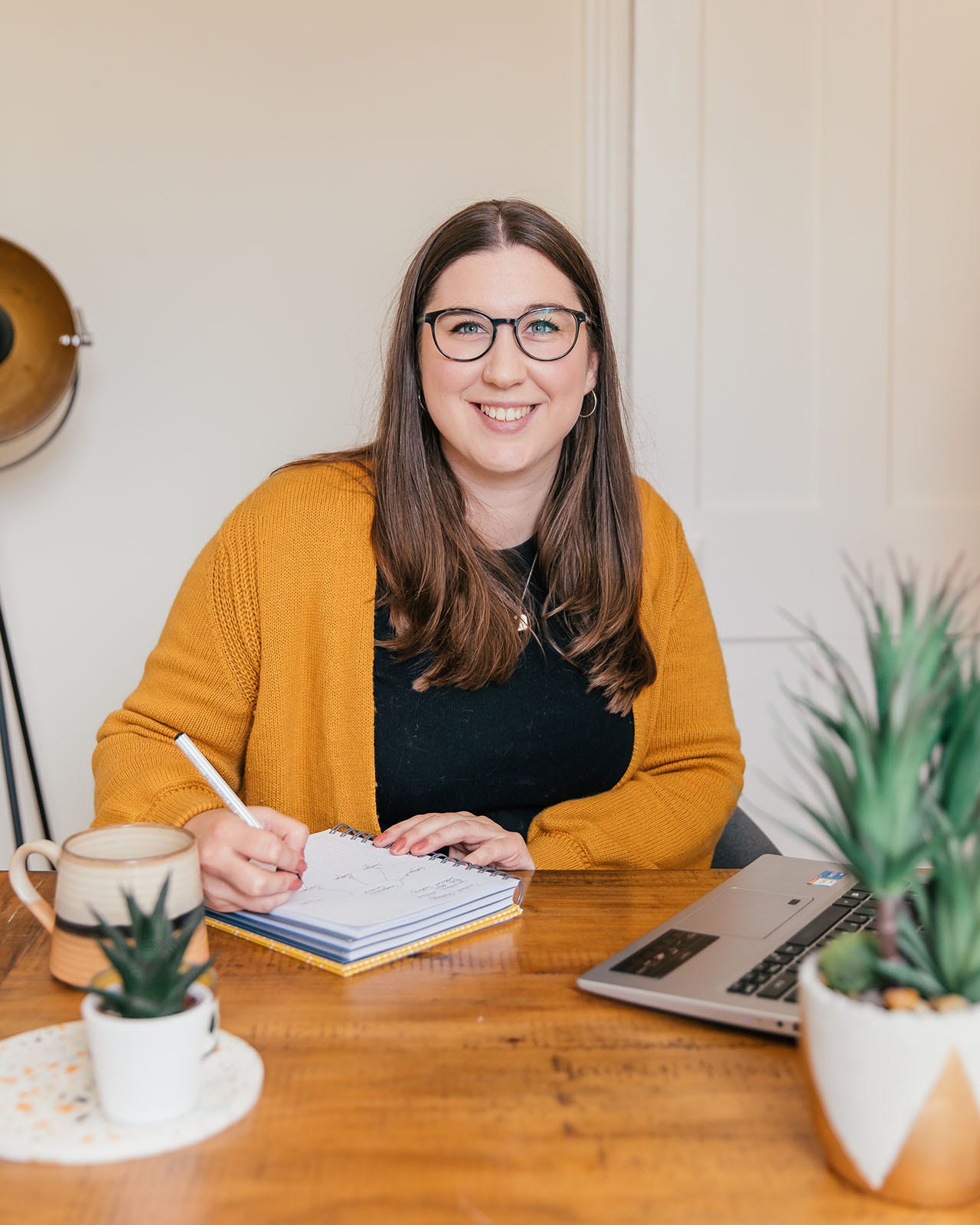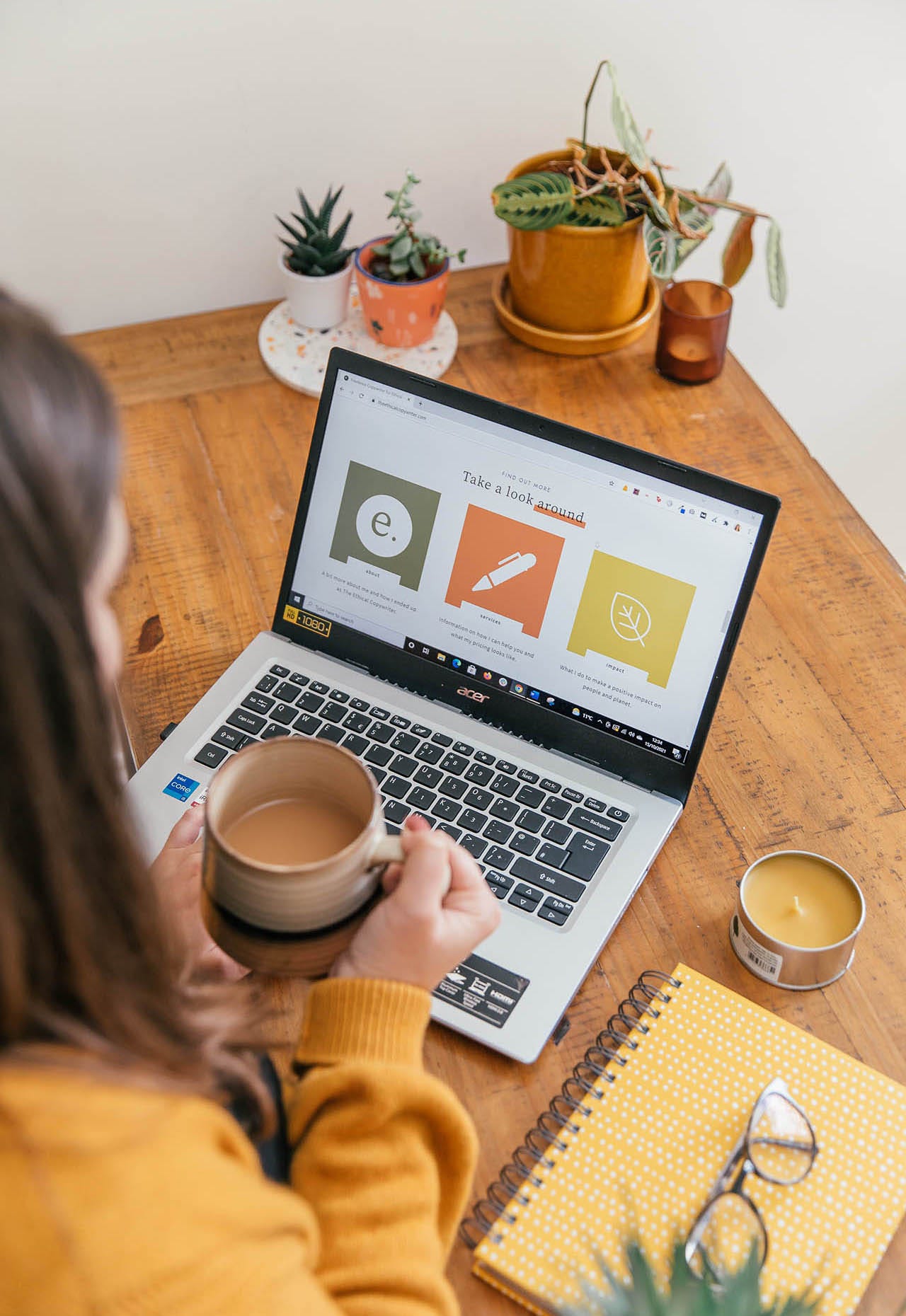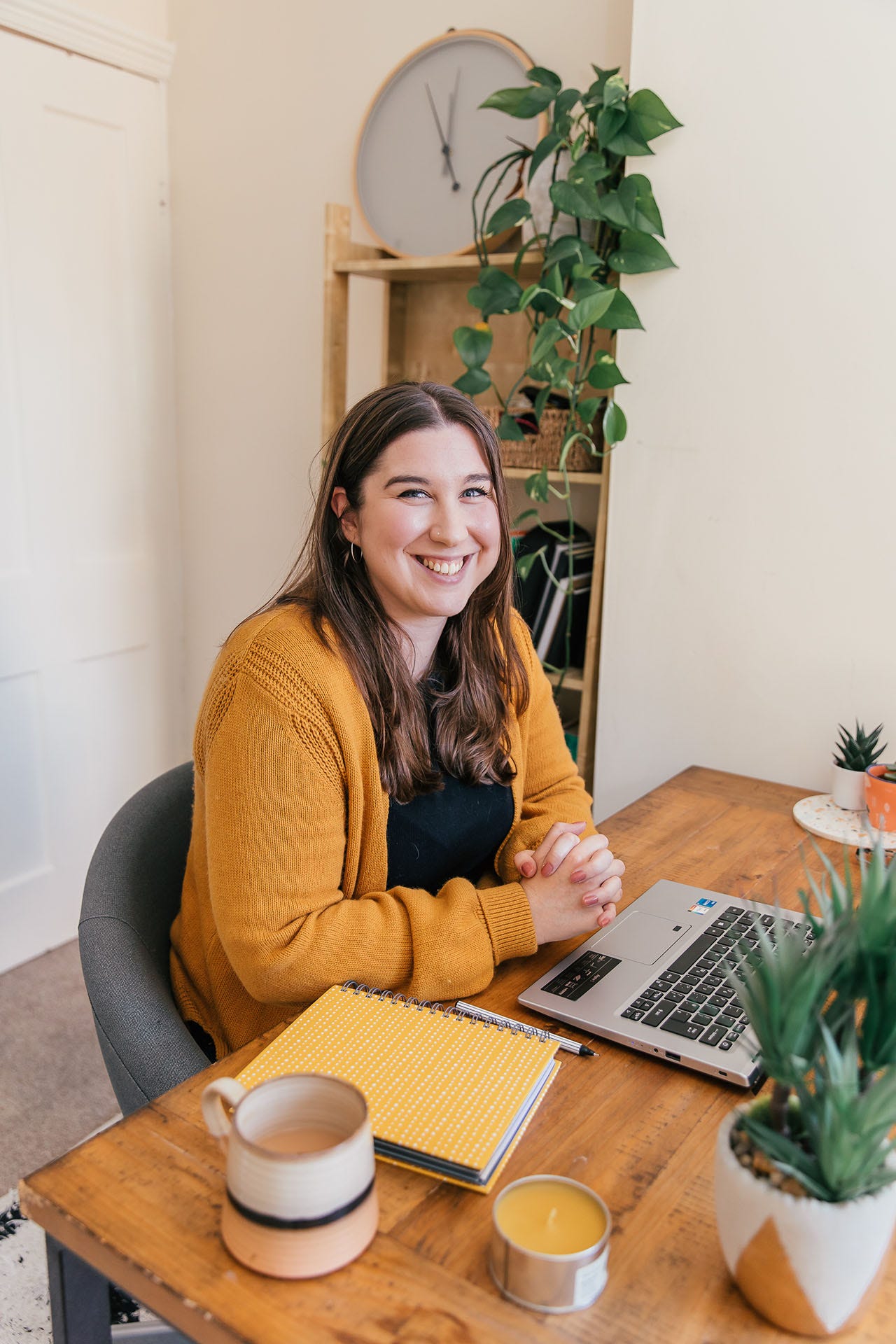How I Create: Rachel Baker, The Ethical Copywriter
An interview with Rachel Baker on building her business, how her writing process has developed over time, and what ethical copywriting looks like in practice.
Rachel Baker works with ethical and sustainable companies to create inspiring content and web copy, and to develop a clear tone of voice for their brand.
As well as working with companies that make an effort to do good in the world, Rachel also focuses on creating copy that is ethical in itself – that is, copy that converts into sales and other actions without manipulating, misleading, or playing on people’s vulnerabilities.
In this interview, Rachel talks about keeping the faith in her first year of business while building up her client base, what ethical copy looks like in practice, and the writing process that helps her stay productive without burning out.
Can you tell us a bit about your background and story so far. How did you get into copywriting, and how did your business get started?
I took a bit of a wiggly route to get to where I am, but every twist and turn contributed to getting me where I am today – doing a job I love!
After leaving university, where I studied English and German, first I pursued a career in translation. I did a stint at a translation agency in Hamburg and then spent a good few years working for agencies as a freelance translator.
Being able to write is essential to translation. In some ways it’s a form of copywriting, but rather than using a brief as a basis, I was using a German text. I translated a lot of marketing materials, which stood me in good stead for pursuing copywriting later on.
Alongside translation I took on a part-time job at a start-up eCommerce company, doing a mix of German customer service and copywriting for their product descriptions and website. From there I decided to find a full-time job as a copywriter. While I really enjoyed translation, I wanted to pursue the creativity of copywriting.
I worked for a couple of years as a copywriter at an SEO agency, where I also learned SEO and became Head of Content, coordinating content strategies for all clients. My partner then got a job in Birmingham and we decided to relocate, so I got a job as Content Specialist at a finance company.
However, two weeks later the pandemic struck and I was left jobless and furlough-less! Luckily, as I had worked freelance before, I had some idea what I was doing and was able to start getting freelance copywriting work. I remembered that I loved working for myself and decided to pursue a dream I’d always had of working for ethical and sustainable companies.
As well as choosing to work with ethical businesses, you also take an ethical approach to copywriting itself. Can you share a bit about what this means to you?
Of course! So, copywriting is writing to persuade. However, there’s a line between persuasion and manipulation. An ethical copywriter is able to describe the benefits of something without misleading, creating a false impression, or playing on negative emotions like anxiety or insecurity. When people are spending money or taking an action, they should be making an informed decision based on all the facts.
For more tips on this, I recently wrote a guest post for Social Media For Humans on how to create copy that converts without manipulation!
An ethical copywriter is able to describe the benefits of something without misleading, creating a false impression, or playing on negative emotions like anxiety or insecurity. When people are spending money or taking an action, they should be making an informed decision based on all the facts.
What does your creative process look like, and (how) has this evolved since you first started your business?
For client work, I have a very set writing process that helps me maintain productivity without getting burnt out. For each blog post or piece of copy, I split the work into three stages: research/planning, drafting, and editing/proofing. I have set times of day that I devote to each stage and spread each piece of work across at least three days. For me, having these breaks and coming back to my work with fresh eyes a few times helps ideas develop and makes my editing more objective and analytical.
So, every work day, the first hour of the day is for proofing/editing – whatever I have in the workflow that needs editing at that time. Then, after a break and maybe some emails, I spend 1-2 hours on drafting. This is writing first drafts of things – I literally just get anything out on the page so I’ve got something to work with the next day when I come to edit. Then afternoons, when I typically have lower energy and concentration, is for researching and planning. I’ll get the tunes on and take notes, read etc.
Creating this system was game-changing for me. Before that, I really struggled to get stuff done and stay creative. I was trying to plan, write and edit a piece of content all on one day and I just couldn’t do it! I think I work quite intensely and am very focused, so I need to take decent breaks to counteract that.
How do you manage your time across the different aspects of your life and business? What does a typical day or week look like for you?
I generally stick to a rough Monday to Friday 9-5 for my work but allow myself some flexibility. For example, if I’m feeling a bit tired I might have a bit of a rest in the afternoon then work from 4 until 6 or 7.
What sort of projects does your work encompass?
I do a mixture of content writing and copywriting. The content writing is blog posts and articles for clients, and I’m lucky enough to have some clients who do really interesting stuff, so I get to write about topics around sustainability and ethical business. I enjoy writing these articles as I get to read around subjects I find really interesting, and I think my clients value that I really put thought into my pieces and try to bring a unique perspective.
The other part of my work is copywriting and tone of voice work. This is more creative work such as helping brands create a verbal identity that reflects their values and writing copy that encapsulates that and helps get their customers onside. I love helping companies create a tone of voice and getting into the nitty gritty of how to make their brand come to life through wording and grammar choices. The English part of my degree was all about analysing language and I still find it fascinating!
What’s the most valuable lesson you’ve learned about your creative process so far?
Definitely to give things time. I find that the best ideas happen in the in-between times when you’re not actively thinking about stuff. I see sitting at my desk as feeding my brain and then while I’m walking the dog or cooking dinner or in the shower, my brain’s working away on ideas in the background. That’s why I’d never agree to turn around copy in one day – good ideas take time!
I find that the best ideas happen in the in-between times when you’re not actively thinking about stuff. I see sitting at my desk as feeding my brain and then while I’m walking the dog or cooking dinner or in the shower, my brain’s working away on ideas in the background. That’s why I’d never agree to turn around copy in one day – good ideas take time!
What’s the biggest challenge you’ve faced in business so far? How have you worked through this?
I’d say there have been two – one was learning how to organise my time and the other was getting through the first year financially (and mentally) while waiting for my client base to build up.
Time organisation was a big learning curve in the early days. When you work for yourself there are so many different tasks to do – creative stuff, emails, marketing, accounts – that it’s really easy to get overwhelmed trying to do everything at once. From talking to others in the freelance community and reading books like Atomic Habits by James Clear and Solo by Rebecca Seal, I learnt that having a daily routine and designated times for different tasks was the way forward.
Then there was plugging away at my business in the first year and having faith that what I was doing would work. I’ve only ever done inbound marketing – using social media, networking and SEO – rather than cold messages and emails. This worked with my business ethos as I wanted to build trust with my potential customers rather than being pushy. If you’re consistent, it pays off – which it did – but it does take time. You just need to hold your nerve and wait for the clients to come! One way to get through it is to focus on the positives and what you have achieved rather than what you haven’t yet.
What are your top tips for someone who wants to go freelance or start their own creative business?
I’d say that if you have that real pull to do it then you’re probably the right kind of person for freelancing. It’s hard work but I wouldn’t want to do anything else. So be brave! But also, be sensible. I think figuring out your target customers and a solid marketing plan before you get started is key.
What books or other resources have you found most useful for starting and running your business?
I mentioned a couple of books earlier, but another game-changing read for me was Company of One by Paul Jarvis. It’s all about creating a business that works for your life, rather than the other way round. It challenges the traditional views of business growth and encourages you to only pursue the level of growth you need or want.
Also, find freelance communities. The advice and support you get from other freelancers when you’re starting out is invaluable. I’m in a few groups for freelancers – such as the Female Copywriters Alliance and Life, Aligned. Twitter hours are also great for freelancers, e.g. #FreelanceHeroes, #FreelanceChat and, for copywriters, #ContentClubUK.
What’s been your proudest achievement to date?
I think probably signing my first couple of retainer clients. It was really nice to feel like all my hard work had paid off and to have a bit of financial security for the first time since going freelance!
And finally, where can we find out more about you and your work?
On my website you can learn more about me and read my blog posts. I’m currently writing a series of posts on using the power of imagination to create a better world. You can also find me posting on LinkedIn, Twitter and Instagram. I’d love to connect!








